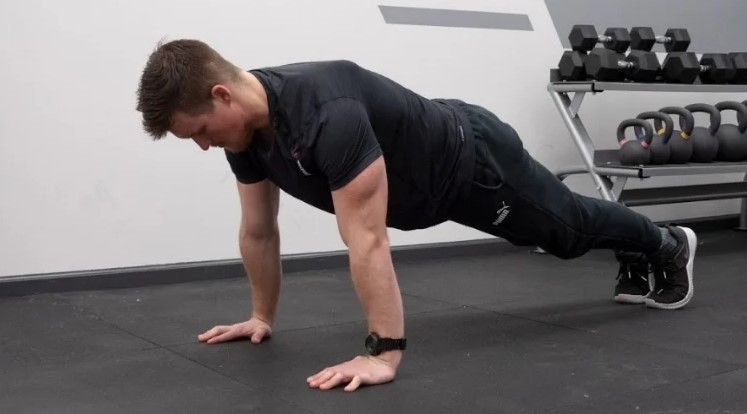It can be tempting for climbers to focus solely on exercises that strengthen pulling motions that mimic those of climbing. However, push-ups are often recommended as part of off-the-wall training for climbing. So, are push-ups good for rock climbing? Color the Crag gives you the full run down.
Push-ups are indeed good training for climbing, because they work the counterparts of the pulling muscle groups. This balance is necessary to avoid injury and maintain healthy posture. Plus, push-ups train your core and chest as well, which will help immensely in climbing.
Let’s look at how push-ups are helpful for climbing in more depth.
Push-Ups Are Good Antagonist Training
Antagonist training is an important technique for climbers, to avoid certain muscle groups becoming far more developed than their counterparts. For example, climbing works for your ‘pulling’ muscles such as those in the back of your shoulders and your upper back while push-ups work your ‘pushing’ muscles in your chest and the front of your shoulders. Push-ups are an ideal way to counteract many of the back and forearm exercises that are typically used to train pulling and grip strength.

If you only work your pulling muscles, your body will likely become imbalanced which can leave you prone to injury or the unfortunate climber hunchback posture. This posture is all too common in climbers, where their overdeveloped back muscles push their shoulders forward, causing their chests to cave in and eventually tightening up their chest muscles. While it may seem counterintuitive to do push-ups as a way to counteract this, it is in fact the most simple way to re-balance your body and posture.
Do a few sets of push-ups before and after a climbing session for this remedy to be most effective. If you can’t do regular push-ups with good form, start with modified push-ups at first until you get stronger. For example, you can lower your knees to the ground, do push-ups against the wall, or otherwise modify the exercise so it works for you while still training your chest.
Push-Ups Strengthen Your Core and Chest
Push-ups are also just good all-around training for your body, strengthening your chest, core, triceps, shoulders, and more. All of these muscle groups are used in climbing, so push-ups are really both antagonist and protagonist training.

While climbing straight up a vertical face will likely mostly use your pulling muscles, there are several different climbing moves or scenarios in which you would need to use other muscles. For example, you may need to mantle up onto a ledge, which is similar to doing a vertical push-up. Or, you might be climbing on an arete (the corner where two vertical planes meet) and need to use compression to hang onto the wall, which requires strong pectoral muscles.
Additionally, core strength is often overlooked but it plays a huge part in climbing ability. Many climbing moves require that you tighten your core in order to keep your body tight against the wall, pull your legs up to a roof section, prevent your body from barn-dooring off the wall, or any one of dozens of other scenarios.
Frequently Asked Questions
How do you build strength for rock climbing?
The easiest way to build strength for rock climbing when you are first getting started is to simply climb more, increasing the frequency, duration, and intensity of your training sessions slowly to avoid injury.
Eventually, you will likely hit a plateau in your strength gains from climbing alone. At that point, basic bodyweight exercises and weightlifting can help you strengthen your body and condition your muscles in order to delay fatigue while you are on the wall and give you the strength and power to climb increasingly more difficult routes.

Stamina is also a big part of rock climbing, so focusing on building your stamina can be just as useful as building muscle strength. Add sustained-effort training to your regimen to increase your body’s aerobic and anaerobic capabilities. You might do laps on a certain route, climbing up, then downclimbing, then repeating that again without stepping off the wall until you can’t continue. HIIT training can also be useful, as well as low-weight, high-rep weightlifting.
What muscles do you need for rock climbing?
Essentially, you need almost every single muscle in your body for climbing, which is why it’s such a good full-body workout. However, many people are hesitant to even try climbing because they feel that they lack upper body strength or because they can’t do a pull-up.
Fortunately, the misconception that you need enormous upper body strength to climb is just that – a misconception. Much of the power in climbing comes from the larger muscles in your legs and your glutes while your arms do less of the heavy lifting. In fact, in slab climbing (on a wall that is less than vertical), you hardly need to use your arms at all other than for balance – you can generally lean into the wall and place your entire weight on your toes.
While of course it helps to be generally fit and strong for rock climbing, it’s also important to maintain balance in your body and in your training, and not to focus on one specific muscle group that you ‘need’ for climbing. If you train your back, be sure to train your chest as well. If you train your grip strength, be sure to train the opposing muscles in your forearms as well.
